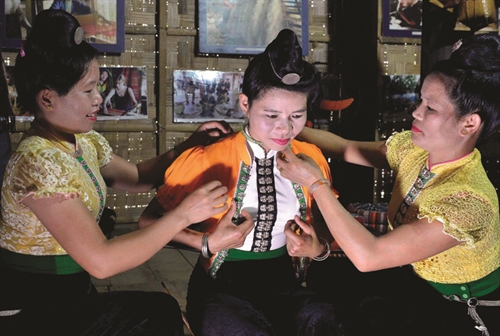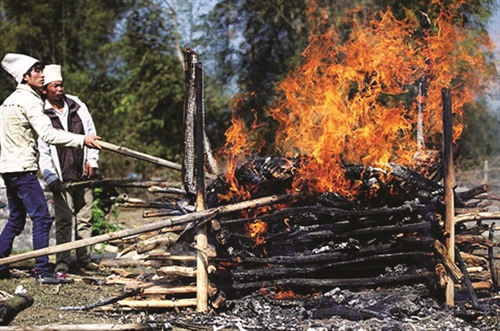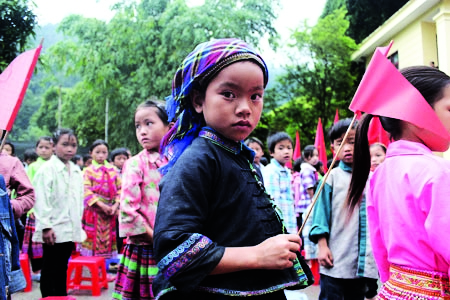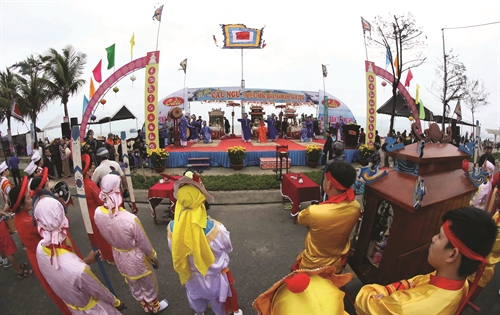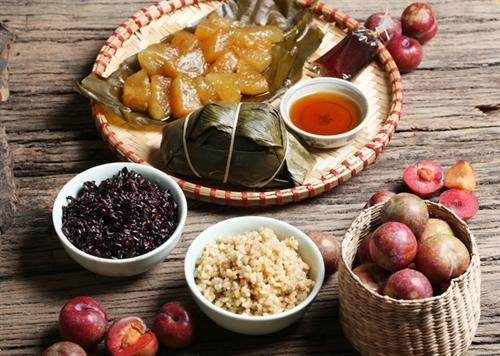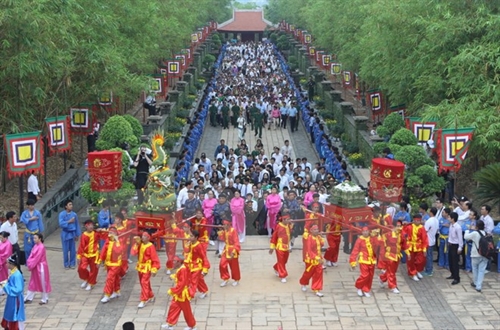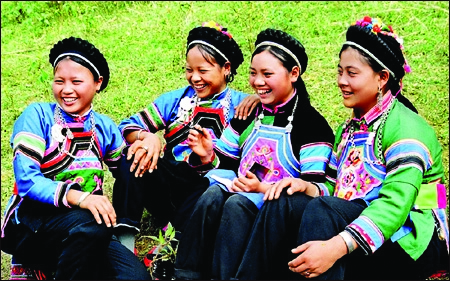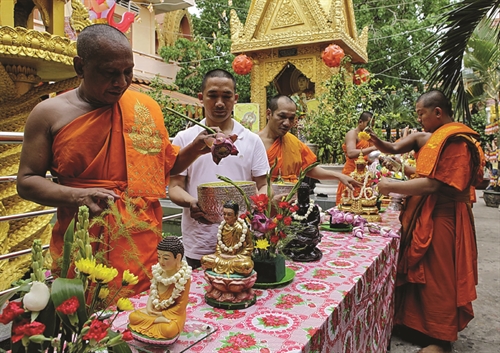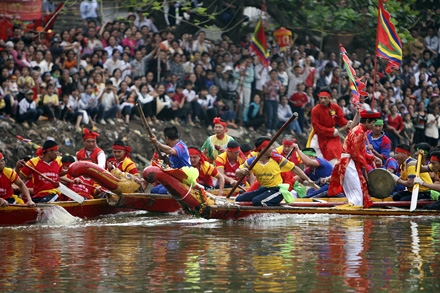>>Nung ceremony upholds a child’s learning
Nguyen Tham Thu Ha
Ethnology Institute
The Nung Din, a small ethnic group living in Vang Leng village, Tung Chung Pho commune, Muong Khuong district, Lao Cai province, attach great importance to giving a proper funeral and burial to their deceased parents as it is considered the last deed children can do to show gratitude to their parents before they are separated forever.
Fulfilling the filial obligation to his parents is one of the three most important things a Nung Din is supposed to do in his life. The other two are building a home and getting married.
Being rich or poor, literate or illiterate, a Nung Din always takes good care of his parents and does everything to please them. When his parents get sick, he does his best to help them recover, from treatment with traditional herbs to rituals to win gods’ support for the sick, no matter how much it might cost. When his parent passes away, a child is supposed to hold a funeral with all required rituals to pay respect and gratitude to the deceased.
When his parents reach the age of 45, a child is supposed to prepare a coffin for each of them no matter the parents are well or sick. The date for making the coffins must be carefully chosen by a shaman based on the birth dates of the parents. On this date, a tray of offerings must be prepared for a ritual to report to the family’s ancestors on this event and pray for their help. The boxes, which are built carefully from precious wood such as rosewood, ironwood and mahogany, are placed near the parents’ beds. They may be neither sold nor lent. They must also be clearly marked for the father and mother.
A Nung Din funeral goes through various rituals which, though pretty complex, must be strictly followed as the group believes missing any of these rituals means the living has not fulfilled their responsibilities to the deceased. These rituals include informing the community, choosing the gravesite, bathing the dead person, laying the dead body in the coffin, paying respects, and escorting the dead person to the grave.
Informing the community
When a person takes his last breath, a son of the family beats three drum rolls or shoots a flint-lock three times into the air to announce the family’s mourning to villagers and ask for their help.
The family clan then meets to select a funeral conductor who must be an old man conversant with customary rules. The funeral conductor will assign tasks to clan members. He also takes charge of inviting a shaman to conduct rituals to lead the dead’s spirit to heaven to meet his ancestors.
Choosing the gravesite
This is an important ritual which must be performed by a geomancer. The Nung Din believe if the dead person has a good resting place, he will enjoy peace in the afterworld and can help family members as well as the whole village.
Based on the dead person’s age and the time and date of his death, the geomancer will tell the family the direction to which the grave must be dug so that the dead person can protect and help the living.
The location of the grave can be chosen by the family as long as it faces the direction advised by the geomancer but it must not be in front of or behind another grave. If a new grave is supposed to face the same direction of an old one, it must be placed next to the old one.
Bathing the dead person
Before the dead person is laid in the coffin, the bathing ritual must be conducted in which the dead person is bathed and has his hair cut by his son. If the dead is a woman, the bathing is performed by her daughter and daughter-in-law who will also cut her nails and comb her hair. The son or daughter then dresses his or her father or mother in new clothes and puts a silver coin in his or her mouth. Seven sets of clothes and a piece of cloth, used as a blanket, are also prepared for the dead person, which will be put into the coffin. If the dead is a woman, this number is nine.
After the dead person is bathed, he is laid on a mat placed in front of the altar with his head toward the altar. Burnt incense is stuck near the head of the dead person while a tray of offerings, including rice, meat and liquor, is placed near his feet. The shaman sits at the right side, if the dead is a man, or the left side, for a woman, reciting prayers to take the dead’s spirit to heaven while children and children-in-law of the dead wearing new clothes and jewelry stand at two sides.
Laying the dead body into the coffin
At the auspicious time which has been carefully chosen by the shaman, the ritual to lay the dead body in the coffin starts. The shaman walks around the coffin, waving a torch while reciting prayers to get rid of evil spirits and call for the dead person’s spirit to enter the coffin. The dead person’s children together move his body into the coffin with the eldest son holding his head. In the meantime, the clarion band plays a tune to see off the dead to his new world.
After that, the coffin is placed in the middle part of the house for mourners to bid a final farewell. On the coffin are placed two cast iron ploughshares to prevent cats from jumping over the coffin. It is believed that if a cat jumps over the coffin, the corpse will be alive.
Children of the dead person take turns to keep vigil over the coffin around the clock to guard unexpected events.
Paying respect
The coffin remains in the house for one or two days and villagers come and pay their respects. Mourners bring money, rice or liquor as offering to the dead person according to their ability and closeness to the family. When a mourner arrives, the shaman will call out his name to inform the dead person of his visit and pray for the dead person’s help for this person. The family then serves a meal to mourners as a way to thank them.
Children of the dead must have separate offerings. The sons’ offerings are usually a paper charnel house and a buffalo or pig while the daughters offer a small pig, a pair of ducks stuck with rice ears, cakes and money. Relatives usually offer a pair of chickens, sticky rice, cakes and liquor.
Escort to the grave
At the chosen time, the shaman prays to ask for the ancestors’ permission for the bereaved to escort the dead person to his/her new home. The procession is headed by a person holding a big torch, followed by the clarion band, the paper charnel house and the coffin carried by the family and friends.
When the procession arrives at the gravesite, the clarion band plays mourning tunes while the shaman says prayers for the dead person to stay peacefully in his new home. Then the coffin is lowered into the grave and buried. The oldest son is the first person to throw a handful of earth into the grave. This act is repeated by the other children of the dead and mourners to say goodbye. After the burial is over, the family places a bowl of rice and a bottle of liquor onto the grave and burns the paper charnel house and incense. Around the grave are placed pots, basins and kerosene lamps. On the way back home, mourners wash their hands at a nearby stream and must dry their hands over a fire before entering home in the belief to keep the dead’s spirit from accompanying them. The family then has a meal together with mourners to thank them.
Dry funeral
A ma kho (dry funeral) will be held for a dead person without going through the above rituals because the family is too poor to afford a funeral at the time of his death.
A dry funeral is held just like a real one with similar rituals conducted by the shaman except that there is no coffin. In the escort ritual, the family carries the paper charnel house and votive papers to the grave and burn them. Two trays of offerings are placed at the grave, one for the dead and the other for the god of mountain. After all votive papers are burnt out, the family members change their mourning clothes and dry their hands over a fire at the grave.
Exhumation
Exhumation is rare in the Nung Din community but may be done if advised by a shaman. When a family suffers misfortunes such as death or serious illness of a family member, childlessness or constant crop failures, it will seek advice from a shaman who will cast lots to see if the mishaps are caused by tremor under the dead’s grave. If yes, the family will hold an exhumation ceremony to move the dead person’s remains for re-burial in another place, which is chosen by a geomancer, in hopes to secure peace for both the dead and the living.-
